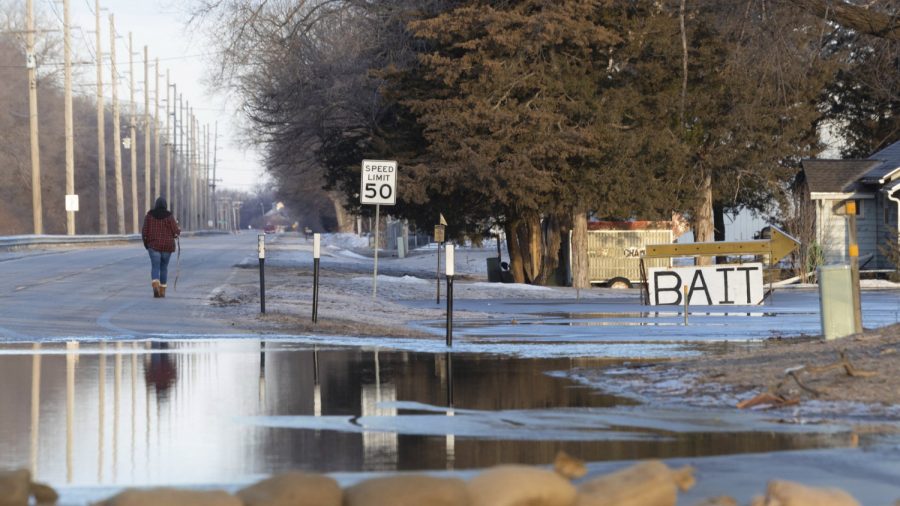OMAHA, Neb.—Authorities used boats and large vehicles on March 16 to rescue and evacuate residents from parts of the Midwest where a recent deluge of rainwater and snowmelt poured over frozen ground, overwhelming creeks and rivers, killing at least one person.
The scramble to move people out of harm’s way was expected to subside at the beginning of the new week, as rivers and creeks flooded eastern Nebraska and western Iowa and expected to crest both Saturday and Sunday. This left officials downstream looking to prepare for likely flooding.
Missouri Gov. Mike Parson (R) had already met with emergency management team members on March 15 to review and update flood-response plans, and the Missouri Highway Patrol was preparing additional equipment and putting swift water rescue personnel on standby. The Missouri National Guard also temporarily relocated the 139th Airlift Wing’s C-130s from Rosecrans Air National Guard Base in St. Joseph as a precaution.
The National Weather Service said the Missouri River at St. Joseph swelled to nearly 26 feet high on Saturday, about a foot below what’s considered to be a major flooding at the northwest Missouri city. However, the flood level is expected to crest at 29.3 feet on either March 20 or 21—more than two feet above major flooding level.
Evacuation efforts in eastern Nebraska and some spots in western Iowa on Saturday were hampered by reports of levee breaches and washouts of bridges and roads, including part of Nebraska Highway 92, leading in and out of southwest Omaha. Authorities confirmed a bridge on the highway that crosses the Elkhorn River had been washed out Saturday.
In Fremont, west of Omaha, the Dodge County Sheriff’s Office issued a mandatory evacuation for some residents after floodwaters broke through a levee along the Platte River. In Mills County, Iowa authorities ordered residents in some rural areas to evacuate after the Missouri River rose above the levees.
The flooding followed days of snow and rain, record-setting in some places, which swept through the West and Midwest. The deluge pushed some waterways, including the Missouri River, to record levels in Nebraska, South Dakota, Iowa, and Minnesota. For many places it was the worst flooding in nearly a decade.
A family is morning the loss of Columbus farmer James Wilke, 50, who died after a bridge collapsed on March 14 while he was trying to reach stranded motorists using his tractor. His body was found downstream, his cousin Paul Wilke told the Columbus Telegram. Gass Haney Funeral Home confirmed James Wilke’s death.
At least two other people were missing in floodwaters in Nebraska. Officials confirmed a Norfolk man was on top of his flooded car late March 14 before being swept away in the water with another man after a dam collapsed on the Niobrara River.
Officials in Sarpy County, south of Omaha, said power may be shut off to communities along the Missouri, Platte, and Elkhorn rivers for safety reasons. They warned those who ignore calls to evacuate would only be rescued during daylight hours. Some cities and towns, such as North Bend on the banks of the Platte River, have already been inundated. Others, such as Waterloo and Fremont, are surrounded by floodwaters, stranding residents in virtual islands without access in or out.
“There is no way out of here unless you’ve got a helicopter—or a boat,” the Rev. Mike Bitter, pastor of Christian Church of Waterloo, told the Omaha World-Herald.
Officials in western Iowa and eastern Nebraska are urging people not to drive unless it is necessary. In Iowa, a section of northbound Interstate 29 that runs parallel to the Missouri River has closed due to flooding. Authorities were rerouting motorists at Kansas City, Miss., using a detour that takes people almost 140 miles (225 kilometers) out of the way.
Farther east, the Mississippi River saw moderate flooding in Illinois from Rock Island south to Gladstone. Meteorologist Brian Pierce from the National Weather Service’s Quad Cities office in Davenport, Iowa, said flooding on the Mississippi could worsen in the next few weeks as more snow melts in Minnesota and Wisconsin.
“What we’re having now is the dress rehearsal for the main event that’s going to happen in early April,” he said of the flooding on the Mississippi.
Rising waters along the Pecatonica and Rock rivers flooded some homes in the northern Illinois cities of Freeport, Rockford, and Machesney Park. The National Weather Service said record crests were possible along the rivers, with water levels forecast to continue to rise over the next several days and remain above flood stage through most of the weekend.
Freeport resident Mary Martin told the Freeport Journal-Standard she went to the store to get milk and bread when she saw floodwaters rise on March 15.
“Within an hour of going to the store, I could not get back in. That’s how fast the water was coming up,” she said.
By Margery A. Beck with additional reporting by Caryn Rousseau.

